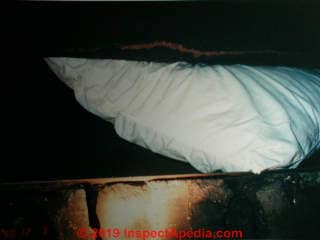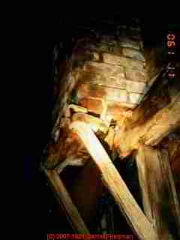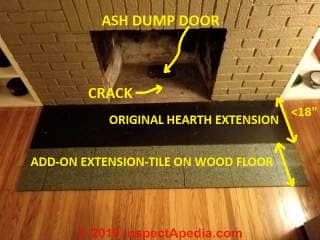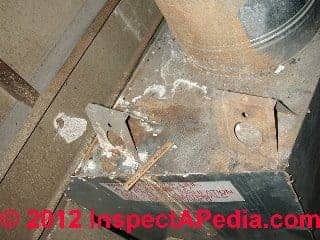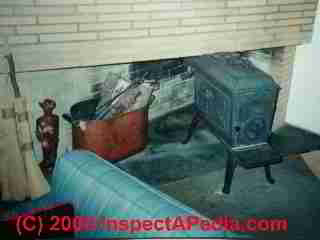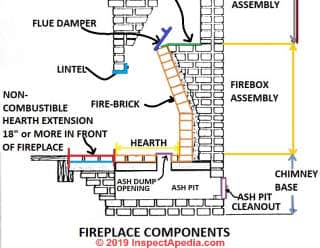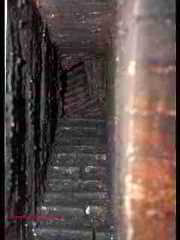 Fireplace Inspection Procedures & Checklist
Fireplace Inspection Procedures & Checklist
Tips from a Chimney Sweep & from code experts
- POST a QUESTION or COMMENT about procedures for inspecting fireplaces, hearths, chimneys from inside the building
Fireplace safety & structural inspections - indoor procedures:
This article describes Fireplace Inspections performed from indoors, listing a professional chimney sweep's fireplace and chimney hazard checklist for problems that can be found by visual inspection at the fireplace or chimney cleanout.
InspectAPedia tolerates no conflicts of interest. We have no relationship with advertisers, products, or services discussed at this website.
- Daniel Friedman, Publisher/Editor/Author - See WHO ARE WE?
Fireplace Inspection Checklist
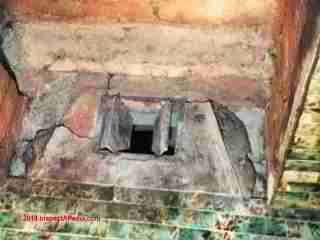 In the 1980's Bill Murphy, Hudson Valley Chimney Sweeps, met with New York Metro ASHI home inspectors to list his biggest safety worries when inspecting a fireplace or fireplace chimney flue from indoors.
In the 1980's Bill Murphy, Hudson Valley Chimney Sweeps, met with New York Metro ASHI home inspectors to list his biggest safety worries when inspecting a fireplace or fireplace chimney flue from indoors.
Here is the list of masonry fireplace safety concerns in alphabetic order, not in order of level of risk. I [DF] have added some items to Bill's original list. Gas fireplace and gas log heater inspection and construction articles are listed separately at the end of this page.
From a variety of fire safety inspection sources we have added a few items beyond what Murphy originally listed, and readers are welcome to us to add other inspection suggestions.
- Ash dump shared between a fireplace and a heating appliance such as an heating boiler.
A shared ash dump risks chimney draft problems for both appliances, unsafe or improper heater operation, and possible movement of dangerous or fatal carbon monoxide or flue gases out of the heating system and into the building's occupied space.
Watch out: some older homes used a shared flue among fireplaces and heating appliances on different floors - a practice that is considered unsafe and is prohibited today. Also check that no wood furring was left in place during the ash dump opening construction. - Chimney cleanliness & chimney cleanout openings: check the ash dump opening the fireplace hearth floor for proper operation and for any exposed wood left from construction, and check for a fireplace ash dump pit cleanout door below - again for proper construction and for condition of the door itself: if the cleanout door doesn't shut tightly fireplace and chimney draft will be poor; the ash dump may need cleaning and should not contain any combustible materials.
Watch out: some ash dumps and cleanout doors may be shared among multiple flues or fireplaces - check for improper air or chimney vent connections between floors or fireplaces.
See details at CHIMNEY CLEANOUT DOORS
Watch out: do not use a fireplace whose chimney and flue are of un-known condition. Creosote deposits or cracks and damage risk a fatal building fire. Have such flues inspected by a certified chimney sweep.
- Chimney leaks: at the chimney top, anywhere along its run, or even from ground-water entry in some cases, can lead to damage making the chimney unsafe. For a complete inspection of the entire run of the chimney a chimney sweep and chimscan camera are needed, but often there are indirect cluses of chimney leaks that show up as rust or stains on the fireplace damper or in the fire box.
- Combustion air: is there a supply of outdoor combustion air (required by codes in some jurisdictions for new construction)?
Look for signs of inadequate combustion air such as smoke stains and sooting on walls and ceilings near the fireplace
Details are at COMBUSTION AIR REQUIREMENTS - Common brick instead of fireplace (refractory) brick used in the fireplace firebox.
Watch out: This softer form of brick absorbs moisture and can explode during a hot fire, sending masonry shrapnel out into the occupied space. - Cross-Vents between chimney flues: chimney flues that leak into one another, such as leaks between a heating appliance flue and the fireplace flue.
As above, this condition risks potentially fatal carbon monoxide poisoning as well as improper draft for both fireplace and heater. Bill uses a mirror to look upwards into the chimney from the cleanout opening.
We have also found breaks between a fireplace flue and heating flue by observing boiler or furnace noises that were louder at the fireplace opening. The heating flue must be entirely separated from the fireplace or woodstove flue.
Watch out: this defect is dangerous but can be very difficult to spot. If you hear the heater running when listening at the fireplace, or if odors, smoke, gases exit at the fireplace when the heater is running, or if there are fireplace draft or heater draft problems there may be an opening between the fireplace flue and heater flue - a chimney sweep using a Chimscan can inspect the flues of both systems.
- Damper operation: is a working fireplace damper in place? Above we show a pillow that had been stuffed into a fireplace after the original damper rusted away.
Watch out: Check that any wood support used to hold the damper in place during original construction was removed to avoid a fire path into surrounding wood-frame structure. We report just such a house fire
at PYROLYSIS EXPLAINED
- Gallows bracket inspection: if the chimney or fireplace breast are supported by a bracket (as opposed to suport by solid masonry to a footing at ground level) inspect the support system's condition and adequacy as else there is a risk of dangerous chimney or fireplace collapse.
See details at BRACKET CHIMNEYS & GALLOWS BRACKETS
- Gaps or cracks at the hearth, firebox, or chimney due to hearth settlement or chimney movement are very dangerous, risking a building fire. That hazard is even greater if fireplace construction left wood exposed to heat or flame.
Details are
at FIREPLACE DAMAGE & UNSAFE HEARTHS
- Hearth safety: does the fireplace hearth extension hearth extend 18" or more past the fireplace opening and is it made of non-combustible materials?
The add-on hearth extension shown in my photo above may have covered small burns and cosmetic damage from embers falling out of the fireplace and past the original (too narrow) hearth, but thin-set tiles directly atop combustible wood flooring may not provide long-term fire-safe protection against heat from the fireplace. We also notice a crack in the fireplace hearth floor near the ash dump door - worth further inspection.
Check that the hearth does not conduct heat directly to combustible subflooring or framing (fireproof insulation may have been used if the entire hearth extension is not solid masonry)
Check that the hearth is adequately supported from below and is not sagging, cracked, damaged
Check that the wood cribbing used to construct an original solid masonry hearth was removed and that no wood or support form a fire hazard (such as a masonry hearth that was built around rather than on-to floor joists).
See details at FIREPLACE HEARTH DIMENSIONS & SUPPORT
- Heatilator-type fireplaces, steel rust-out: Murphy indicated that steel "heatilator" style fireplaces that are 20-25 years old are at very high risk of having rusted out and become unsafe.
Rain falling down a chimney rusts out the smoke shelf - a condition that you may not be able to see but can feel by hand. Bill suggests rapping on the steel fireplace components and listening for falling rust. - Smoke detectors missing - easy to correct,
Watch out: do not use the fireplace or woodstove unless smoke detectors are installed properly and at the recommended locations. - Wood framing or forms left in place below the hearth, above the flue damper risk an eventual house fire either from sparks or coals falling through hearth cracks onto the framing, or by repeated heating to high temperatures and the process of pyrolysis that lowers the combustion point for wood.
See details at PYROLYSIS EXPLAINED - Wood framing or forms visible through the ash dump opening, a fire hazard.
No wood should be in the ash dump opening or ash dump path or storage area as coals from a fire can set this framing on fire.
- Zero clearance? we have found a few zero-clearance fireplaces improperly installed too close to combustibles. Details are
at FIREPLACE INSERTS INSTALL, INSPECT, REPAIR.
Visible Inspetion of Fireplace Flue Condition
At FIREPLACE INSERTS INSTALL, INSPECT, REPAIR
we detail the exploration of the condition of a cast-iron "fireplace" or fireplace grate that was originally intended for burning large chunks of coal, probably soft coal. This installation was found in a home built in Poughkeepsie NY ca 1900 and restored by the author.


Modern Fireplace Inserts for Burning Wood, Coal, Pellet Fuel
A modern fireplace insert for burning wood is shown at left. You can see why inspecting the chimney from inside is impossible without removing the appliance.
This installation is particularly interesting. If you click to enlarge the photo you can see light colored bricks at the right of the fireplace insert: the installer appears to have bricked the original fireplace opening to better fit the new insert.
Watch out: adding a fireplace insert that moves the fire doors closer to the edge of the hearth reduces fire clearance (for heat or if the doors are open, sparks and coals) between the appliance opening and nearby combustibles or flooring.
The owners have placed a "fireproof rug" in front of this unit - that semi-circular carpet observed on the floor. Is this adequate? Be sure to consult your local fire inspector when installing or converting a fireplace or fuel burning appliance.
Unsafe Fireplace Inserts
By "fireplace insert" we refer to a wood or coal-burning stove designed to be inserted into an existing masonry fireplace opening.
The wood-stove installed in the fireplace at left may work in such a location, but it was not designed as an "insert" - and does not fit the opening of this odd fireplace. In fact not much would fit in this angled firebox.
Placing the feet of the woodstove past the hearth and onto a rug, as well as less than 3' from combustibles, are further fire hazards - this is an unsafe installation.
Details are at FIREPLACE DAMAGE & UNSAFE HEARTHS.
Fireplace Safety
- Helwig, Larry, & Mary Ann Sward, WOOD STOVE AND FIRE AND FIREPLACE SAF EPLACE SAFETY AND MAINTENANCE [PDF] (1979) South Dakota State University Cooperative Extension Service, &. U.S. Department of Agriculture
...
Reader Comments, Questions & Answers About The Article Above
Below you will find questions and answers previously posted on this page at its page bottom reader comment box.
Reader Q&A - also see RECOMMENDED ARTICLES & FAQs
Question: is removing wood around chimney cleanout door a big job?
How do you remove wood framing or forms visible through the ash dump opening in the basement. Found by house inspector and buyers want it removed for safety purposes. A chimney person or a mason? Is this a costly procedure?
[Click to enlarge any image]
Reply: advice on repairing fireplace hazards in a home for sale
Mary
I'd need to at the very least, see photos and the home inspection report to understand what the hazard appears to be.
Is the wood around the ash dump opening in the floor of the fireplace (purple line in my drawing) or is the wood around a chimney ash-pit cleanout door (purple rectangle) that in my sketch above?
[Click to enlarge any opening]
The location of the wood and how it was affixed in place determine whether it's trivial to remove ($100. or less, 5 minutes by a handyman to pull out loose, tacked exposed furring strips) or instead will be a troublesome and more-costly job $un-determined work by a professional mason or chimney sweep).
Examples of chimney cleanouts and safety concerns with them are
Watch out: Also you'll want to have an expert review the whole fireplace installation to be sure that there is not other hard-to-spot wood exposed and forming a fire hazard in the chimney constructions.
On New Years' Eve 1969 in Poughkeepsie our house caught fire because of exposed wood that had been left in the construction of a masonry fireplace - a 2x4 left as a "temporary" support for the damper during construction.
Hansey left the wood in place - it was nearly impossible to remove without breaking masonry. And some of those fireplaces, after years of exposure to heat and sparks, ultimately set the house on fire.
Details of that event are at PYROLYSIS EXPLAINED
So KUDOS to your home buyer's inspector - pass along my compliments. The inspector might have saved trouble for both you (from liability) and the homeowners (a fire). The actual level of risk also varies from very low to quite significant. As you read in my anecdote exposed wood in a fireplace can linger for decades before finally starting on fire.
Now just how hard it is to remove the wood in question depends on exactly what's there and how it's secured. The job ranges from trivial - a handyman and 5 minutes of effort - to significant. I can't guess without knowing the details.
My OPINION is that it is usually better for a seller to give an allowance to buyers for repairs for which she, the seller, agrees to be responsible.
The benefits to the seller include avoided liability, and the avoidance of discovery of additional hidden damage that cause a job to mushroom.
The benefits to the buyer include the ability to be in control of the job, to avoid worrying that the seller took a shortcut, and often to economize by combining the required repair with other improvements or changes they want. The contractor who does the work is then responsible to the new owner. In contrast, if the seller hired the repair contractor the buyer has no recourse if they want the job improved, extended, or corrected.
The ash dump repair serving only a fireplace is deferrable - one simply doesn't use the fireplace before it has been inspected by a certified chimney sweep or expert mason - for safety and function. That's the most-skilled person to assure that the fireplace, flue, and ash dump are all safe and to remove any exposed wood or other hazards.
IF, despite my (neutral party) advice, you and buyers insist that you have the work done (as your attorney will perhaps advise, after all it doesn't cost the attorney a dime to spend your money to simplify their life), you should hire a professional chimney sweep to inspect the whole system and make necessary repairs.
Otherwise you risk putting buyers at risk of other more-hidden fire safety hazards and you have created a liability for yourself should, heaven forbid, Dan Martin not be present when the new owners build their next hearty fire in the fireplace of their new home.
A photo of our home where the fire occurred is shown - no damage was visible from outside.
Reader comment:
(Sept 26, 2011) Anonymous said:
the best info.
Reply:
Thanks anon. We also welcome question or content suggestions.
...
Continue reading at FIREPLACE DAMAGE & UNSAFE HEARTHS or select a topic from the closely-related articles below, or see the complete ARTICLE INDEX.
Or see these
Recommended Articles
- FIREPLACES & HEARTHS - home
- BRACKET CHIMNEYS & GALLOWS BRACKETS
- CHIMNEY CLEANOUT DOORS
- CHIMNEY FIRE ACTION / PREVENTION
- CHIMNEY FLUE INSPECTION CAMERA
- CHIMNEY DRAFT & PERFORMANCE
- COMBUSTION AIR DEFECTS
- CREOSOTE DEPOSITS, FIRE HAZARD
- FIREPLACE CHIMNEY ROOF CLEARANCE
- FIREPLACE & WOODSTOVE CONTAMINANTS
- FIREPLACE DAMPER DEFECTS, REPAIRS
- FIREPLACE FLUE SIZE SPECIFICATIONS
- FIREPLACE HEARTH DIMENSIONS & SUPPORT
- FIREPLACE INSERTS INSTALL, INSPECT, REPAIR
- FIREPLACE INSPECTIONS
- FIREPLACE INSPECTION PRE-FAB
- FIREPLACE DAMAGE & UNSAFE HEARTHS
- GAS FIREPLACES & GAS LOGS - home
- GAS FIREPLACE VENT CLEARANCE REQUIREMENTS
- GAS FIREPLACE CERAMIC STAINS
- INACCESSIBLE CONNECTIONS FIREPLACE, WOODSTOVE
- RUMFORD FIREPLACE DESIGN RULES
- PYROLYSIS EXPLAINED
- WOOD BURNING FIREPLACE ROOF CLEARANCE
Suggested citation for this web page
FIREPLACE INSPECTIONS at InspectApedia.com - online encyclopedia of building & environmental inspection, testing, diagnosis, repair, & problem prevention advice.
Or see this
INDEX to RELATED ARTICLES: ARTICLE INDEX to CHIMNEYS & FLUES
Or use the SEARCH BOX found below to Ask a Question or Search InspectApedia
Ask a Question or Search InspectApedia
Try the search box just below, or if you prefer, post a question or comment in the Comments box below and we will respond promptly.
Search the InspectApedia website
Note: appearance of your Comment below may be delayed: if your comment contains an image, photograph, web link, or text that looks to the software as if it might be a web link, your posting will appear after it has been approved by a moderator. Apologies for the delay.
Only one image can be added per comment but you can post as many comments, and therefore images, as you like.
You will not receive a notification when a response to your question has been posted.
Please bookmark this page to make it easy for you to check back for our response.
IF above you see "Comment Form is loading comments..." then COMMENT BOX - countable.ca / bawkbox.com IS NOT WORKING.
In any case you are welcome to send an email directly to us at InspectApedia.com at editor@inspectApedia.com
We'll reply to you directly. Please help us help you by noting, in your email, the URL of the InspectApedia page where you wanted to comment.
Citations & References
In addition to any citations in the article above, a full list is available on request.
- Roger Hankey is principal of Hankey and Brown home inspectors, Eden Prairie, MN, technical review by Roger Hankey, prior chairman, Standards Committee, American Society of Home Inspectors - ASHI. 952 829-0044 - hankeyandbrown.com
- Thanks to Luke Barnes for suggesting that we add text regarding the hazards of shared chimney flues. USMA - Sept. 2008.
- American Gas Association - New Vent Sizing Tables
- Brick Institute of America - Flashing Chimneys
Brick Institute of America - Proper Chimney Crowns
Brick Institute of America - Moisture Resistance of Brick - [8] BOCA Fire Inspector Guidebook, A Correlation of Fire Safety Requirements Contained in the 1987 BOCA National Codes, (newer edition available), Building Officials and Code Administrators International, Inc. (BOCA), Country Club HIlls, IL 60478 312-799-2300 4th ed. Note: this document is reissued every four years. Be sure to obtain the latest edition.
- Chimney Safety Institute of America - Chimney Fires: Causes, Effects, Evaluation
- Cohen, Donald V., "Chimney Inspection Procedures & Codes," This article was to be published in the first volume of the 1994 ASHI Technical Journal by D. Friedman, then editor/publisher of that publication. The production of the ASHI Technical Journal and future editions was cancelled by ASHI President Patrick Porzio. Some of the content of Mr. Cohen's original submission has been included in this more complete chimney inspection article: CHIMNEY INSPECTION DIAGNOSIS REPAIR . Copies of earlier editions of the ASHI Technical Journal are available from ASHI, the American Society of Home Inspectors.
- Costello, Martine, & Josh Kovner, "Rooftop View Turns to Darkness," New Haven Register, 12 May 1992 p. 11: Catherine Murphy was sunning on a building roof when a chimney collapsed; she fell into and was trapped inside the chimney until rescued by emergency workers.
- GAMA - Gas Appliance Manufacturers' Association has prepared venting tables for Category I draft hood equipped central furnaces as well as fan-assisted combustion system central furnaces.
- [9] International Association of Fireplace and Chimney Inspectors, Inc., IAFCI, 5325 N Commerce Ave Ste 5 Moorpark, CA 93021, Website: http://www.membersiafci.org/
- Murphy, Bill & Hansen, Bob, "Top Ten Chimney (and related) Problems Encountered by One Chimney Sweep," Hudson Valley ASHI education seminar, 3 January 2000, contributed by Bob Hansen, ASHI
- [7] National Chimney Sweeps Guild, NCSG, 2155 Commercial Drive, Plainfield, IN 46168, Tel: 317) 837-1500, Website: http://www.ncsg.org/ , Email: mmcsweeney@ncsg.org
- [8] National Fireplace Institute - NFI, Website: http://nficertified.org/ Quoting from the associations website:
The National Fireplace Institute® is the professional certification division of the Hearth, Patio & Barbecue Education Foundation (HPBEF), a 501(c)3 non-profit educational organization for the hearth industry. - National Fuel Gas Code, an American National Standard, 4th ed. 1988 (newer edition is available) Secretariats, American Gas Association (AGA), 1515 Wilson Blvd., Arlington VA22209, and National Fire Protection Association (NFPA), Batterymarch Park, Quincy MA 02269. ANSI Z223.1-1988 - NFPA 54-1988. WARNING: be sure to check clearances and other safety guidelines in the latest edition of these standards
- NFPA 211 - Standards for Chimneys & Fireplaces, NFPA 211: [book at Amazon] Standard for Chimneys, Fireplaces, Vents, and Solid Fuel-Burning Appliances, 2006 Edition (older editions and standards are found at the same bookstore)
- Natural Gas Weekly Update: http://tonto.eia.doe.gov/oog/info/ngw/ngupdate.asp Official Energy Statistics from the U.S. Government
- New York 1984 Uniform Fire Prevention and Building Code, Article 10, Heating, Ventilating, and Air Conditioning Requirements
- New York 1979 Uniform Fire Prevention & Building Code, The "requirement" for 8" of solid masonry OR for use of a flue liner was listed in the One and Two Family Dwelling Code for New York, in 1979, in Chapter 9, Chimneys and Fireplaces, New York 1979 Building and Fire Prevention Code:
- NFPA #211-3.1 - Specific to chimneys, fireplaces, vents and solid fuel burning appliances.
- NFPA # 54-7.1 - Specific to venting of equipment with fan-assisted combustion systems.
- NFPA 211 - 3-1.10 - Relining guide for chimneys
- NFPA 211 - 3-2 - Construction of Masonry Chimneys
- NFPA 211 - 3-3 - Termination Height for chimneys
- NFPA 211 - 3-4 - Clearance from Combustible Material
- NFPA 54 - 7-1 - Venting of Equipment into chimneys
- Reinmiller, Mark J., P.E., "Chimneys and Vents," Mark J. Reinmiller, P.E., ASHI Technical Journal, Vol. 1 No. 2 July 1991 p. 34-38.
- Uniform Mechanical Code - UMC 1991, Sec 913 (a.) Masonry Chimneys, refers to Chapters 23, 29, and 37 of the Building Code.
- US Energy Administration: Electrical Energy Costs http://www.eia.doe.gov/fuelelectric.html
- Our recommended books about building & mechanical systems design, inspection, problem diagnosis, and repair, and about indoor environment and IAQ testing, diagnosis, and cleanup are at the InspectAPedia Bookstore. Also see our Book Reviews - InspectAPedia.
- [9] Armhein, James E., E.E., Masonry Fireplace and Chimney Handbook, 2nd Ed., [sold at Amazon] M.I.A. Masonry Institute of America, 22815 Frampton Ave. Torrance, CA 90501-5034 Toll free: 1-800-221-4000; the original text noted that mIA was prepared to include requirements of the 1994 UBC and other codes. Website ht.masonryinstitute.org
- DeMayo, Robert D., Fireplaces, Friend or Foe, [book at Amazon]
- Chimney Inspection Checklist, Carson Dunlop, Associates, Toronto, Ontario
- Chimney & Stack Inspection Guidelines, [book at Amazon]American Society of Civil Engineers, 2003 - These guidelines address the inspection of chimneys and stacks. Each guideline assists owners in determining what level of inspection is appropriate to a particular chimney and provides common criteria so that all parties involved have a clear understanding of the scope of the inspection and the end product required. Each chimney or stack is a unique structure, subject to both aggressive operating and natural environments, and degradation over time. Such degradation may be managed via a prudent inspection program followed by maintenance work on any equipment or structure determined to be in need of attention. Sample inspection report specifications, sample field inspection data forms, and an example of a developed plan of a concrete chimney are included in the guidelines. This book provides a valuable guidance tool for chimney and stack inspections and also offers a set of references for these particular inspections.
- Gitlin, Jane, Fireplaces, a Practical Design Guide, [book at Amazon]
- In addition to citations & references found in this article, see the research citations given at the end of the related articles found at our suggested
CONTINUE READING or RECOMMENDED ARTICLES.
- Carson, Dunlop & Associates Ltd., 120 Carlton Street Suite 407, Toronto ON M5A 4K2. Tel: (416) 964-9415 1-800-268-7070 Email: info@carsondunlop.com. Alan Carson is a past president of ASHI, the American Society of Home Inspectors.
Thanks to Alan Carson and Bob Dunlop, for permission for InspectAPedia to use text excerpts from The HOME REFERENCE BOOK - the Encyclopedia of Homes and to use illustrations from The ILLUSTRATED HOME .
Carson Dunlop Associates provides extensive home inspection education and report writing material. In gratitude we provide links to tsome Carson Dunlop Associates products and services.



